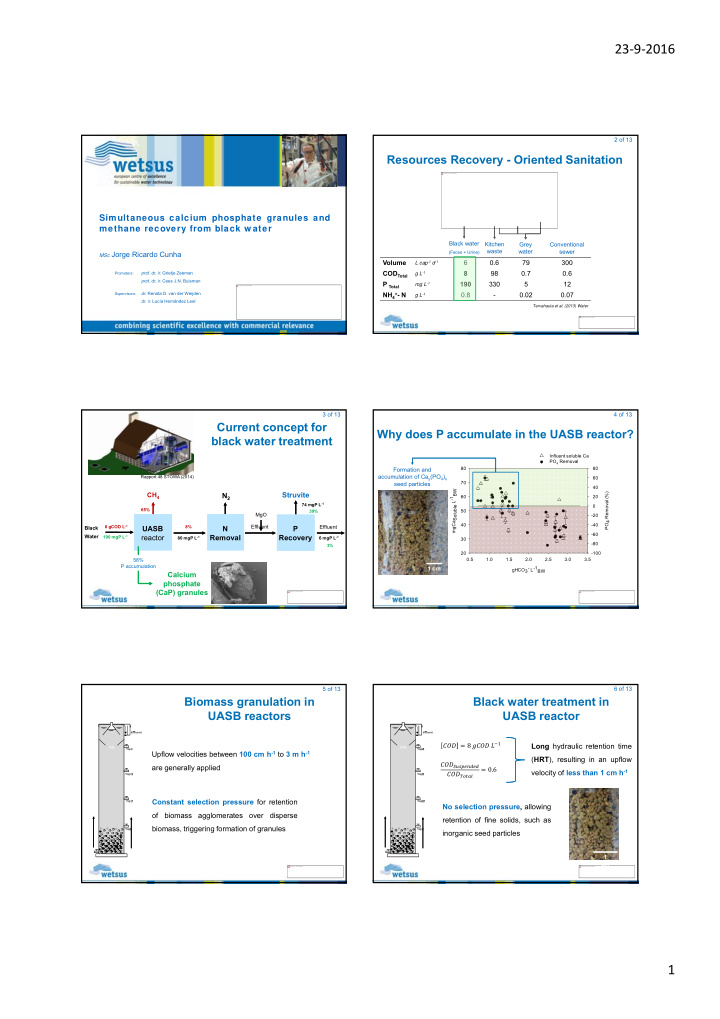



23 ‐ 9 ‐ 2016 2 of 13 Resources Recovery - Oriented Sanitation This image cannot currently be displayed. Simultaneous calcium phosphate granules and methane recovery from black w ater Black water Kitchen Grey Conventional waste water sewer MSc Jorge Ricardo Cunha (Feces + Urine) Volume L cap -1 d -1 6 0.6 79 300 prof. dr. ir. Grietje Zeeman COD Total 8 98 0.7 0.6 Promoters: g L -1 prof. dr. ir. Cees J.N. Buisman P Total 190 330 5 12 mg L -1 This image cannot currently be displayed. Supervisors: dr. Renata D. van der Weijden NH 4 + - N 0.8 - 0.02 0.07 g L -1 dr. ir. Lucía Hernández Leal Tervahauta et al. (2013) Water This image cannot currently be displayed. 3 of 13 4 of 13 Current concept for Why does P accumulate in the UASB reactor? black water treatment Influent soluble Ca PO 4 Removal Formation and 80 80 accumulation of Ca y (PO 4 ) x Rapport 48 STOWA (2014) 60 70 seed particles 40 mgCaSoluble L-1BW Struvite CH 4 N 2 PO4 Removal (%) 60 20 74 mgP L -1 0 65% 39% 50 MgO -20 40 -40 8 gCOD L -1 UASB 8% N Effluent P Effluent Black -60 reactor Removal Recovery Water 190 mgP L -1 80 mgP L -1 6 mgP L -1 30 -80 3% 20 -100 58% 0.5 1.0 1.5 2.0 2.5 3.0 3.5 P accumulation 1 cm gHCO3- L-1BW Calcium phosphate (CaP) granules This image cannot currently be displayed. This image cannot currently be displayed. 5 of 13 6 of 13 Biomass granulation in Black water treatment in UASB reactors UASB reactor ��� � 8 ���� � �� Long hydraulic retention time Upflow velocities between 100 cm h -1 to 3 m h -1 ( HRT ), resulting in an upflow ��� ��������� are generally applied � 0.6 velocity of less than 1 cm h -1 ��� ����� Constant selection pressure for retention No selection pressure, allowing of biomass agglomerates over disperse retention of fine solids, such as biomass, triggering formation of granules inorganic seed particles 1 cm This image cannot currently be displayed. This image cannot currently be displayed. 1
23 ‐ 9 ‐ 2016 7 of 13 8 of 13 Formation of CaP granules from seeds Formation of CaP granules from seeds Backscattered �� �� � �� � �� � �� �� � �� � �� � �� � 1 �� � 1 SEM image 5 � ��,��� 5 � ��,��� Increase of Ca in BW Increase of Ca in BW Microbial colonization SEM-EDX analysis Formation of an outer biofilm �� �� ��� � � � � � → �� � � ��� � � � � � � � 4� � → �� � � 3� � � ��� � This image cannot currently be displayed. This image cannot currently be displayed. 9 of 13 10 of 13 Formation of CaP granules from seeds Formation of CaP granules from seeds �� �� � �� � �� � �� �� � �� � �� � �� � 1 �� � 1 5 � ��,��� 5 � ��,��� 8,2 pH Micro Sensor Increase of Ca in BW Increase of Ca in BW 8,1 Effluent pH min Preferable accumulation of Effluent pH max 8,0 CaP in the granules 7,9 pH 7,8 Microbial colonization 7,7 Microbial colonization 7,6 Enhances the crystallization 7,5 of Hydroxyapatite 7,4 Formation of an outer biofilm Formation of an outer biofilm 7,3 5�� �� � 4�� � � 3��� � � 0 1 2 3 4 5 6 �� �� ��� � � � � � → �� � � ��� � � �� �� ��� � � � � � → �� � � ��� � � Depth (mm) → �� � �� � � �� � 3� � � � � � � � 4� � → �� � � 3� � � � � � � � 4� � → �� � � 3� � � ��� � ��� � Increase of internal pH (7.4 to 8) Increase of internal pH (7.4 to 8) This image cannot currently be displayed. This image cannot currently be displayed. � � � � ↔ ��� � �� � 2� � ↔ �� � �� �3� � � � � � ↔ ��� � �� � 2� � ↔ �� � �� �3� � � � �� � ↔ � � �� � � � �� � ↔ � � �� � 11 of 13 12 of 13 Hydroxyapatite in the granules (XRD) Higher P accumuation by adding Ca 2+ This image cannot currently be displayed. Struvite HAp This image cannot currently be displayed. This image cannot currently be displayed. 2
23 ‐ 9 ‐ 2016 13 of 13 Impact on treatment concept CH 4 1.9 L CH4 L -1BW N 2 Calcium -1 300 mg L UASB N Effluent Black Removal Water 190 mgP L -1 reactor 15 mgP L -1 8% 92% P accumulation Calcium phosphate (CaP) granules This image cannot currently be displayed. 3
Recommend
More recommend